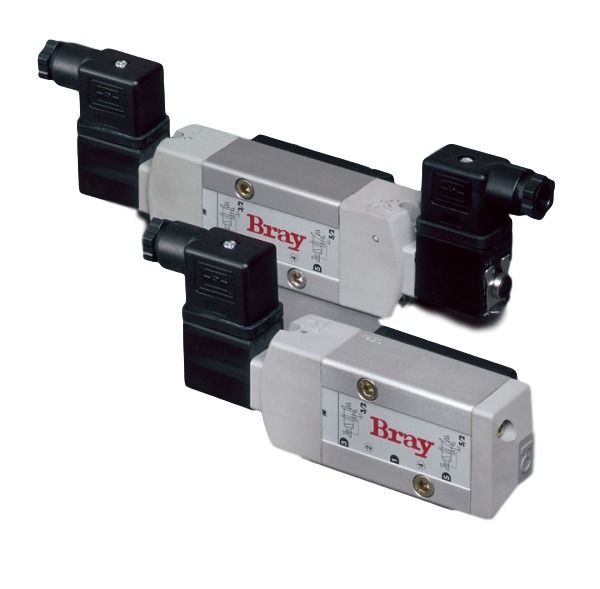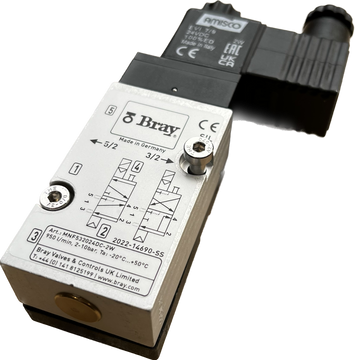How Does a Solenoid Valve Work
Discover how a solenoid valve works! Read about its components, operation, and applications in efficiently controlling fluid and gas flow.

What is a solenoid valve
A solenoid valve (solenoid valve) is an electromechanically operated valve used to control the flow of a medium, such as gas or liquid. The valve operates based on an electromagnetic coil (the solenoid) that controls a movable core (the plunger).
Main component
- Solenoid (coil): A copper wire coil that generates a magnetic field when electric current passes through it.
- Plunger (core): A metal cylinder attracted to the solenoid's magnetic field. This mechanism opens or closes the valve.
- Valve body: This is the part where the plunger moves and the medium flows. It can be made of brass, stainless steel, or plastic.
- Spring: Ensures the plunger returns to its original position (usually closed) when the magnetic field is turned off.
- Connection Ports: Inlets and outlets through which the medium enters and leaves the valve.
Operation
- In the 'closed' position: When no current flows through the coil, a spring holds the plunger in place, blocking the flow.
- In the 'open' position: When current flows through the coil, it creates a magnetic field that pulls the plunger up. This opens the valve and allows the medium to flow.
Applications
- Industrial processes: include chemical processing, the oil and gas industry, and food production.
- Household appliances: For example, washing machines, dishwashers and coffee machines.
- Medical equipment: Control of gas and liquid flows in medical applications.
- Irrigation systems: Automatic water control in garden and agricultural applications.

Different types of solenoid valves
Different types of solenoid valves
Solenoid Valves come in different types and configurations depending on the application and how they work. Below is an overview of the main types of solenoid valves :
1. Based on the default position
Normally Closed (NC)
- Description: The valve remains closed when the coil is not activated. When activated (electric current), the valve opens.
- Applications: Most common type, used in applications where flow is only required when the valve is activated.
Normally open (NO)
- Description: The valve remains open when the coil is not activated. When activated, the valve closes.
- Applications: Used in systems where flow is required as standard and only occasionally needs to be shut off.
2. Based on the operating method
Directly operated solenoid valve
- Description: The plunger opens or closes the valve directly without external pressure.
- Advantages:
- Suitable for low pressures.
- Fast response.
- Applications: Low pressure systems, such as small water flows.
Indirectly operated (servo-controlled) solenoid valve
- Description: Uses the pressure of the medium itself to open or close the valve. A small amount of force from the solenoid controls a diaphragm or pilot orifice, opening or closing the main valve.
- Advantages:
- Suitable for higher pressures and flow rates.
- More energy efficient.
- Applications: Industrial installations, irrigation systems.
Semi-direct operated solenoid valve
- Description: Combines elements of both direct and indirect operated valves. The solenoid directly assists in opening the central orifice and simultaneously uses the medium pressure.
- Advantages: Suitable for a wider pressure range.
- Applications: General industrial applications.
3. Based on the number of ports
2/2 way solenoid valve
- Description: Two ports, one inlet and one outlet. The valve opens or closes the flow completely.
- Applications: Water, oil and gas controls.
3/2 way solenoid valve
- Description: Three ports and two positions. Allows the flow to be diverted or released.
- Applications: Air operated cylinders, pneumatic systems.
4/2 way and 5/2 way solenoid valves
- Description: Multiple ports and positions for complex flow control. Often used in combination with pneumatic actuators.
- Applications: Industrial automation and hydraulic systems.
4. Based on the medium
Fluid solenoid valves
- Designed for water, oil, and other fluids, it is made of materials that are resistant to corrosion and chemical interactions.
Gas or air solenoid valves
- Suitable for compressed air, nitrogen or other gases. Often used in pneumatic systems.
Special solenoid valves
- For aggressive chemicals or high-pressure applications, often made from specialised materials such as PTFE or stainless steel.
5. Based on the design
Single acting solenoid valve
- The solenoid opens or closes the valve and returns to the default position by a spring.
Double acting solenoid valve
- Uses two coils to open and close the valve without a spring.
Solenoid valve Namur / Combined 5/2 & 3/2 way G¼ / 24 V DC
This Solenoid valve Namur spring return offers SIL 1-3 (IEC 61508:2010) safety certification and IP65 protection.
What does NAMUR mean in solenoid valves
In the context of solenoid valves, the term NAMUR refers to a standardization for mounting and interface of pneumatic components, including solenoid valves, on actuators. The Standards working community for Mess and Control technology (NAMUR), a German organization for process automation, developed this standard.
A solenoid valve with a NAMUR interface is designed to be mounted directly to an actuator without additional adapters or complex modifications. It offers a standardized mounting pattern and connections, making installation and replacement simple and universal.
Features of a NAMUR solenoid valve
- Standardized mounting dimensions:
- The screw holes and ports (for air supply and exhaust) are made to a fixed size.
- This allows the solenoid valve to be mounted quickly and without additional brackets on the actuator.
- 2/5-way or 3/5-way configuration:
- Depending on the application, NAMUR valves are typically used in pneumatic applications and offer two-way or three-way control options.
- Compact design:
- The NAMUR interface integrates the solenoid valve seamlessly with the actuator, saving space and installation efforts.
- Double acting or single acting actuators:
- NAMUR solenoid Valves can be adapted to operate with double-acting (air-to-open/air-to-close) and single-acting (spring-return) actuators.
Benefits of NAMUR in solenoid valves
- Universal compatibility:
- Standardization allows manufacturers and installers to easily combine components from different brands without compatibility issues.
- Easy installation and maintenance:
- The modular design saves time when installing, replacing or maintaining the valve.
- Reduced chance of errors:
- The standardized interface reduces the chance of incorrect mounting or connections.
- Flexibility:
- Many NAMUR solenoid Valves come with adjustable plugs to function as either a 3/2-way or a 5/2-way.
Applications of NAMUR solenoid valves
- Process industry: Automating and shut-off valves in the chemical, petrochemical and food industries.
- Pneumatic systems: To operate compressed air actuators.
- Automation: This is for use in valve positioners and industrial process controllers.
